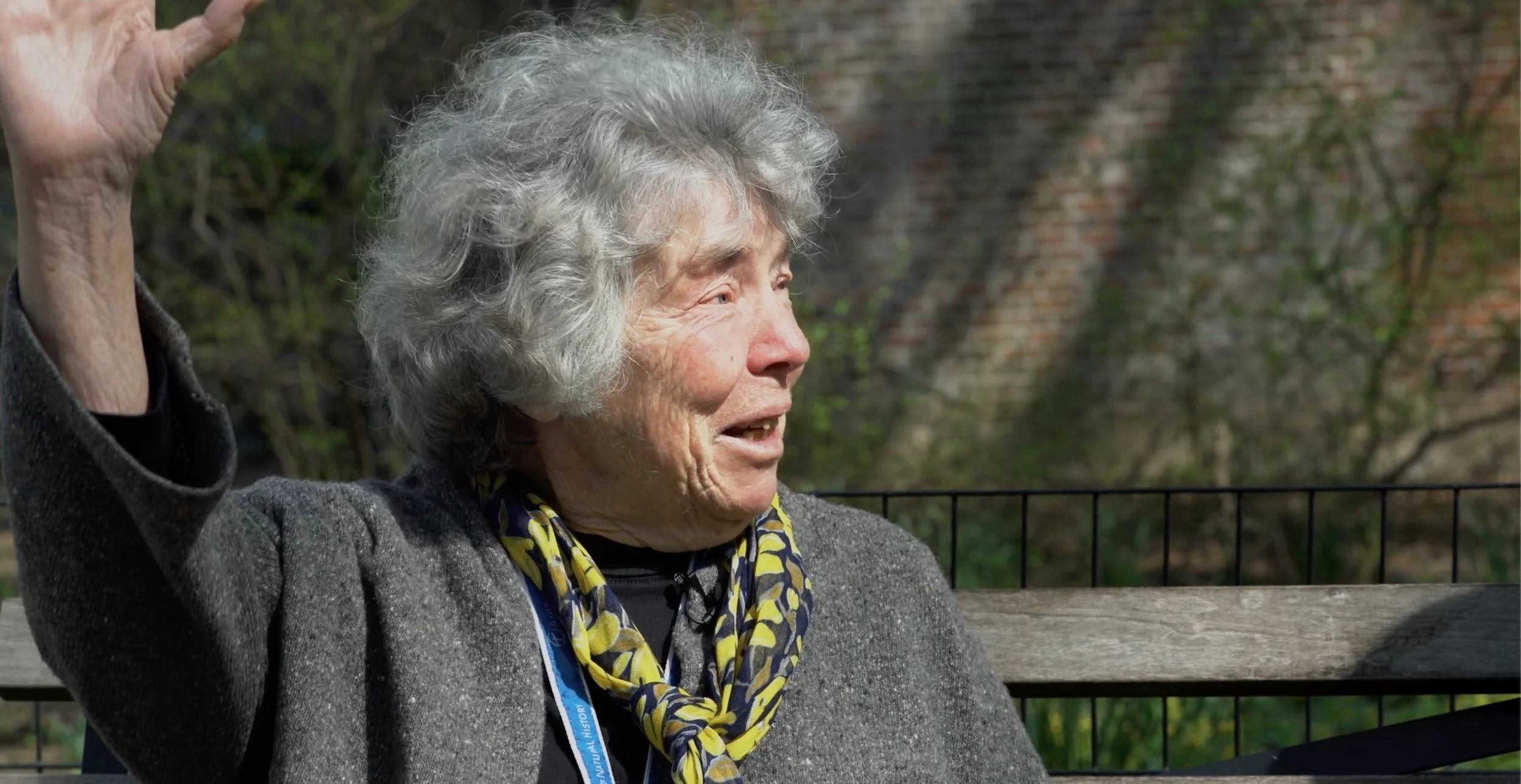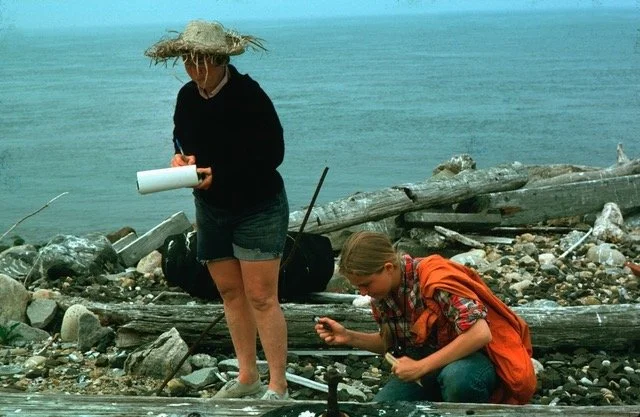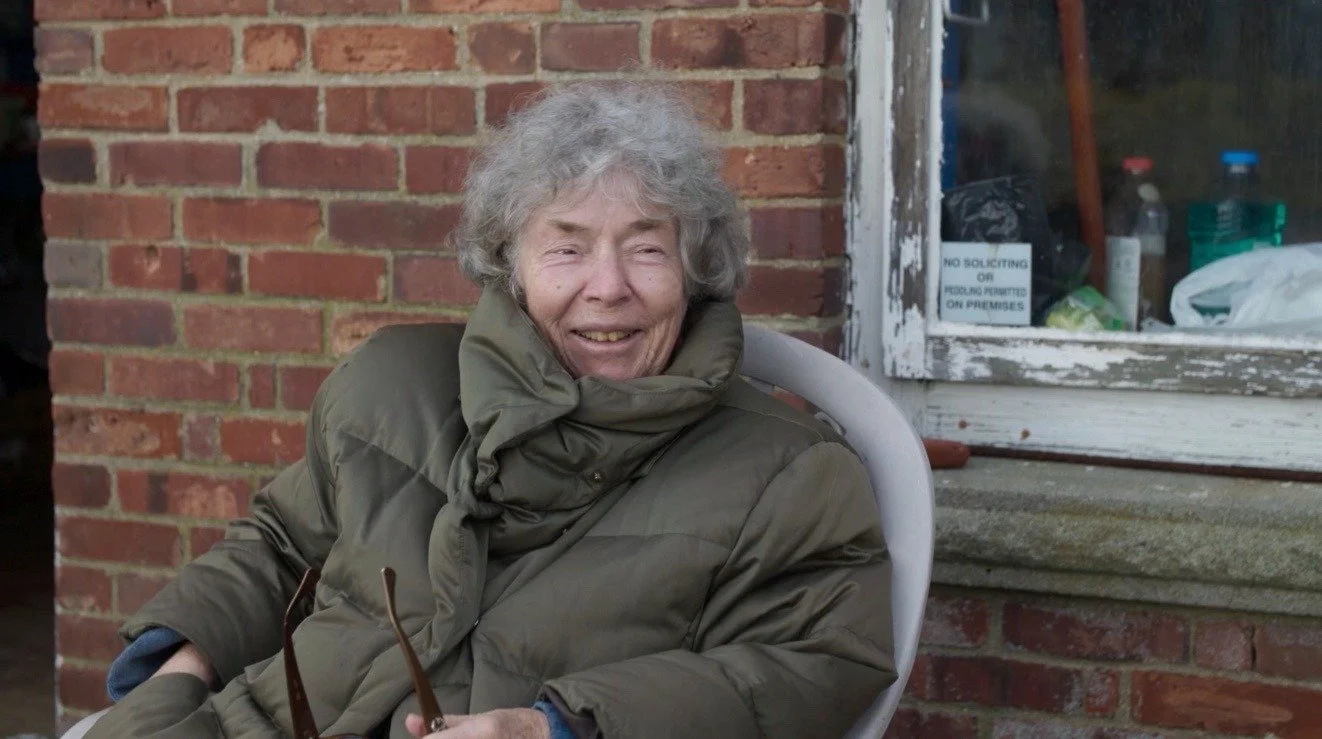
The Great Gull Island Project
The Great Gull Island Project is a monitoring study of Common and Roseate Terns nesting on Great Gull Island, which is in Long Island Sound off Orient Point on the North Fork of Long Island. Additionally GGI connected with scientists in Brazil, Argentina, and the Azores, where many of the banded birds from Great Gull Island spend their non-breeding time. Helen Hays and her team relied on many volunteers each year to help gather data on the island and maintain the site.
HELEN HAYS
Helen Hays directed the Great Gull Island Project (GGI) beginning in 1969. Helen Hays died on February 5, 2025. She was 94. She was a tirelessly dedicated scientist with infectious spunk who gave much of her life to the study of and preservation of terns on Great Gull Island. Common Tern pairs on GGI have increased from 3,000 to 10,000 since 1969 and Roseate Terns are on the rise too. In addition to the numerous published scientific papers generated by the GGI, Helen Hays received many awards for her work including the President’s Volunteer Action Award (1985); Chevrolet Outdoor Conservation Award – National Fish and Wildlife Foundation (1996); Lifetime Achievement Award New York Audubon (1998); and Conservation Service Award U.S. Department of the Interior (2002); Honorary Doctorate from University of Connecticut (2015), where Helen gave the commencement address in May 2015.
A few Helen Hays quotes from Full Circle that highlight her resilience
and her commitment to the Great Gull Island Project:
“Whoever does this later, I think the only thing that I would ask them to do would be to protect the terns here and see that they can nest successfully.”
“We’ve gotten answers to most questions, which is fun! And in finding answers, we found more questions. So it all works that way.”
“It’s funny how you keep being hopeful and every day is a new day.”
Introducing our Great Gull Islanders
The Great Gull Island Project is made possible through the generous contribution of volunteers from every walk of life. We’ve asked some of them to contribute their own thoughts about the impact their experience has made.
To learn more about volunteer opportunities with the Great Gull Island Project please email greatgulloffice@gmail.com.
Augie Kramer, Gull Islander since 2014
“Coming to Great Gull Island for the first time in high school, never could I have imagined a place where such a diverse group of people would come together with a common goal of studying and appreciating terns. I am forever grateful for Helen and the rest of the amazing GGI crew for fostering my love of fieldwork and bird research.”
Talvi Ansel, Gull Islander
“Every time I hear a tern or see a tern flying by I think of Gull Island and Helen's work out there. Full Circle captures all that and makes me very homesick.”
Bear Fox, Gull Islander
“For me, Great Gull Island is the closest place to Heaven on earth. I miss it dearly.”
Grace Cormons, Gull Islander
“One weekend on GGI marking nests in the spring of 1966 influenced the rest of my life. I was “hooked” by the sea, sky, and rocks at GGI, by the feeling of being one with the life of the terns, and most importantly, by Helen’s enthusiasm. These things brought me back year after year.
My husband Matt became involved, as well as sons Peter and Tom. Helen’s contagious energy and interest brought together a special community of volunteers willing to cheerfully work hard- marking nests, trapping, observing, keeping records- from early morning ‘til after late June sunsets. It has been exciting to be part of that community.
Helen kept coming up with questions: wanting to know more about the terns’ behavior and how to increase their numbers on GGI, then where they went when they left the island at the end of the season, then where they went in South America during our winter. Her dauntless spirit oversaw the building of observation blinds, terraces and nest boxes on GGI, led us up and down the east coast 1968-1970 from ME to NC to find banded terns, then, for many of the years 1996-2018, to Brazil and Argentina. The South America trips brought us in touch with Esteban in Argentina and Pedro in Brazil who became important collaborators with the GGI Project. In addition to finding major sites where Common and Roseate terns spend their non breeding season, Helen established wonderful respectful relationships with the local people living in communities along the coast. Then Helen had another question: do Roseate Terns that nest in the Azores ever go to Brazil during our winter? See Full Circle for the answer. By the way, I am still “hooked’.
Joe DiCostanzo, Gull Islander
"Besides my family, Great Gull Island has been the biggest and most important thing in my life. "
Dick Young, Gull Islander
“Great Gull Island, steeped in American history and home to one of the largest tern colonies in the world, is a unique and wonderful place. Far and few are the locations where the average person off the street can go mano a mano with such challenging birds. During peak, when one is stressed and in the thick of it, it is hard to maintain that perspective.
It has been my privilege to have spent 36 summers there. Kudos to Helen for keeping the Project going lo these many years. I know that, having been there, I have been changed for the better, and for good.”
Matthew Male, Gull Islander
I first came to Great Gull in the early 1970’s as a teenager for a weekend. Helen Hays was at a water bird meeting in Australia. My father and 3 of my brothers came also, and we were put to work clearing vegetation (some things never change). It was exciting to explore the old fort and island, I jumped at the chance to return for a few trips the following year, helping my older brother with a film he was making (some things never change). I met Helen who soon put me to work as a handyman (some things never change). I became intrigued by all the life on the island - birds, seals and insects, as well as the people. Through the last 40+ years Gull Island has become the place I think of as home, and the people who work there have become family. I plan my life on shore around my time on the island. I love to welcome the terns every spring.
Peter Paton, Gull Islander
“Great Gull Island provides an incredible opportunity for University of Rhode Island undergraduates to get involved with a critical conservation program. For over 8 years, I have been bringing students to assist with habitat management and creating nesting opportunities for both Common and Roseate terns. Students are so excited to know they are helping to protect the largest Roseate Tern colony in the NW Atlantic, with over 50% of the region's nesting population.”
Loretta Stillman, Gull Islander, since 1984
“I remember the first time I set foot on Gull Island, a graduate student looking for an adventure in Ornithology fieldwork. Bareheaded, I bounced off the dock and into a maelstrom of feathered fury. Hundreds, (seemed like millions) of birds diving at my head, screeching and swooping and raining down bird poop. With my arms over my head I made it to the main headquarters where everyone seemed unperturbed and busily unpacking a boatload of food. They all wore hats. First lesson learned. Above all else, everyone on Gull Island needs a good hat and a poop shirt.
The hats and I did not get along. Standard issue was a straw hat with a crown of sticks attached with duct tape. In theory the sticks gave the birds an attack target above the level of your head. In practice you had to use so much duct tape that the hats became top heavy and slid off your head just as the meanest bird on the Island was going in for the kill. Luckily Helen is always open to new ideas and I suggested perhaps something softer than sticks might work better. On my next trip back to the Island I came loaded with plastic flowers from the Dollar Store. I was in the hat business, sewing plastic daisies or roses, or even orchids onto hats. Helen considered the matter scientifically and by observing hats in the field, determined that yellow daisies were attacked the least. For over twenty years Helen and I always have yellow daisies on our hats.”
Michael Male, Cinematographer/ Producer of Full Circle, Gull Islander since 1974
“May of 1974 as a university student was my first time on Great Gull Island. It was early in the nesting season. The island was still washed fresh by winter, tern courtship calls filled the air, and egg laying had just begun. The weekends were busy with Gull Islanders preparing for the full on nesting yet to come. During the first week I was there Helen and I covered nest check alone. It was all magical to me, and Helen such an amazing teacher!
I unfortunately had to go back to the mainland for a paid summer job the rest of the season, and again in 1975 I was only able to spent the same two weeks of May on GGI, but with Helen’s encouragement hatched a plan to return for the full summer in 1976 - to make a film about the project! A dream come true for me … combining natural history and documentary filmmaking, something I very much had the desire to do but had no experience doing. Helen thought it possible, and that makes it a go! UConn offered me independent study credit in biology & fine arts, a camera (that had been used to film studies of "Birds of Paradise” courtship in New Guinea!) was borrowed from the basement of The Museum and “Ternwatch” was the result in 1977 after months of work. Learning while doing can certainly be effective, and it set me off on a career.
For “Full Circle” I returned to Great Gull Island to film again some 40 years later.
Of the several filming trips the favorite and most magical one for me was early season ... yet again. The experience of seeing the tern flocks first arrive after their long migration was new, and getting to share that excitement with Helen who remains as enthusiastic as ever, was a huge treat!”
Lottie Prushinski, Gull Islander since 1992
“Helen is an inspiration to all Gull Islanders. I have missed being able to o out to the island the past 2 years, hopefully we will all be able to get back out there, clear vegetation, welcome the common and roseate terns back for another season and start marking nests again. Of course we can’t forget those wonderful breakfasts, lunches and dinners that Helen along with the volunteers make, and sitting around after dinner and catching up with everyone. Hope to see everyone soon!”
Verónica Neves, Gull Islander
“Working on GGI in 2017 was an inspiring and heart warming experience. The restoration work done for the birds is amazing and I felt part of the winged-human community from the first moment on the pier! So much fun, learning and discovery. Thank you Helen, for being so open, kind and enthusiastic.”
Matt Cormons, Gull Islander
“Great Gull Island entered my life thanks to my then-girlfriend Grace. From her first visit she loved it so much she wanted to share it with me. In subsequent years I volunteered on GGl, married Grace, and was delighted that our two sons were able to work there with Grace. When Helen learned from her Brazilian colleague Pedro. Lima that he had netted a wintering Common Tern banded in the Azores, she wondered if Roseate terns from the Azores might also winter in Brazil.
At the time, Veronica Neves was the only person banding Roseate Terns in the Azores; Helen reasoned that if more Roseates could be banded, there would be an increased chance others might be netted in Brazil. She asked me if I would be willing to visit the Azores to assist Veronica. So began the first of more than a half dozen trips, two with Grace and one with our younger son Peter, plus a visit to Brazil. The first verified trans-Atlantic record resulted when Peter, as part of the Azorean Roseate team trapped a Roseate his brother Tom had banded 5 months earlier with the GGI team with Pedro in Brazil. Since then, Pedro has netted additional Azorean Roseates there. Our entire family is delighted and honored to have been part of this important research which has enriched my family's lives and brought together conservationists from 3 continents —all thanks to Helen’s vision and enthusiasm.”
Pedro Lima
“In 1995 I discovered the migration route of Sterna dougallii (Roseate Terns) in the State of Bahia, Brazil on a sandbar in Mangue Seco. In 1996 Helen discovered me because of the dozen bands I recovered from S. dougallii (Roseate Terns) banded by Helen at GGI. From 1997 on, we started to work together. It's been exactly 25 years - half the circle completed by Helen.
In these 25 years of working together I could summarize the following discoveries: we discovered the migration route of Sterna hirundo (Common Terns) and S.dougallii (Roseate Terns) from the Azores, Portugal and also the migration of S.dougallii from England. These were major discoveries that changed everything that was known about these two species. We captured thousands of birds in Bahia with bands from North America, the Caribbean, more than a dozen banded birds from the Azores and two S. dougallii banded from England. We monitored more than half of the coast of Brazil for S. dougallii - from the coast of Espírito Santo to Oiapoque in Amapá. We worked hard to get S. dougallii (Roseate Terns) included on the list of endangered species in Brazil.
On the north coast of Brazil, we found that Ceará fishermen were killing the birds to remove the bands. Without any kind of coercion, we managed to reverse the situation and bring the fishermen to the side of the fight to protect the terns (S. dougallii) thanks to the intense work of Environmental Education where communities were included in conservation work.
The main reason for this resulting protection lies in the strength of the communities and their contribution to conservation.”
Margaret Rubega, Gull Islander
“I really believe that it's our responsibility as Great Gull Islanders to ensure that all Helen's work is honored by the conservation of tern populations. There are terns in Long Island Sound because Helen created this colony. Climate change threatens to undo that work, and we must adapt along with the birds.”
Great Gull Island 2024 Annual Update
Greetings Friends of Great Gull Island!
Good news friends, 2024 was an excellent year for both Common and Roseate Terns nesting on Great Gull Island (GGI). The summary below highlights our key accomplishments this past field season. Our focus was to develop a research program that will inform actions to keep the terns going in the decades ahead. We detected record numbers of breeding Roseate Terns and thousands of Common Terns. Productivity was high, mainly due to the large numbers of fish in Long Island Sound that continued from June through July. Luckily, we saw no evidence of Highly Pathogenic Avian Influenza (HPAI), which was great news as this virus can have devastating impacts to seabird colonies. We have instituted biosecurity controls to avoid accidental introduction of the virus from possible onshore sources, and to protect those working in the colony.
Matt Male and Gerry Hauser built two new cabins in 2024, to help move workers out of tents. In 2025, along with our central work of vegetation management and tern monitoring, we hope to complete the cabin building, and add a modern composting “privy”. We’ll be continuing to work toward the replacement of invasive plants with tern-friendly native vegetation. We are also hoping to increase our presence and support of local conservation organizations in the wintering grounds in Brazil, building on Helen’s seminal work there, because protecting the terns means protecting them throughout their full life cycle. We also need to begin the lengthy processes of developing a comprehensive and actionable Biosecurity Plan for GGI and evaluating the erosion of the coastline of the island. Restoration of eroded areas of the rip rap and shoreline are badly needed to protect GGI from the effects of sea level rise and increased storm intensity.
Your support is critical to the activities that keep the GGI colony thriving. We were able to compete successfully for some external grants, but maintaining our presence on Great Gull is always costly. While much of our field work is covered by donated time or grant support, we need your help to restore infrastructure for researchers, manage habitat, monitor the terns, and protect GGI for generations to come. You can help us by making a tax-deductible gift to: Great Gull Island Project-AMNH and mailing it to the Great Gull Island Project, American Museum of Natural History, 200 Central Park West, New York, NY 10024-5102.
Sincerely,
Joan Walsh
Margaret Rubega
Pater Paton









































